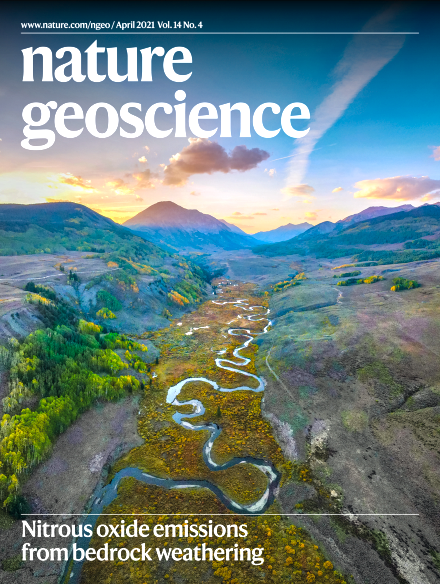
This image shows an aerial view of the East River, central Colorado, United States, flowing through a mountainous watershed underlain by Cretaceous marine shale. The image was the April 2021 cover of Nature Geoscience.
Atmospheric nitrous oxide (N2O) contributes directly to global warming. Although it is known that release rates of nitrogen (N) from bedrock weathering is large, models of N2O fluxes do not consider contributions from bedrock, the largest pool of terrestrial N, as a source of N2O. In this first-of-its-kind field study, bedrock weathering is shown to contribute 78% of the subsurface reactive N, while atmospheric sources (commonly regarded as the sole sources of reactive N in pristine environments) account for the remaining 22%. About 56% of the total subsurface reactive N is denitrified by microorganisms, including 14% emitted as N2O.
Measurements-based calculations and calculations based solely on literature values both suggest that the global terrestrial N-N2O flux (10.0±2.0Tg N-N2O year−1) includes a significant and previously unrecognized contribution of about 10–20% from bedrock weathering, which needs to be accounted for as a source in predictions of global N2O fluxes and their sensitivity to climate change and disturbance.
Summary
Atmospheric nitrous oxide contributes directly to global warming, yet models of the nitrogen cycle to date have not considered bedrock, the largest pool of terrestrial nitrogen, as a source for nitrous oxide. Although it is known that release rates of nitrogen from bedrock are large, there is an incomplete understanding of the connection between bedrock-hosted nitrogen and atmospheric nitrous oxide. Here, we quantify nitrogen fluxes and mass balances along a hillslope underlain by Cretaceous marine shale. We found that, at this site, bedrock weathering contributes 78% of the subsurface reactive nitrogen, while atmospheric sources (commonly regarded as the sole sources of reactive nitrogen in pristine environments) account for only the remaining 22%. About 56% of the total subsurface reactive nitrogen is denitrified by microorganisms, including 14% emitted as nitrous oxide. The remaining reactive nitrogen discharges in porewaters to a floodplain where additional denitrification likely occurs. We also found that the release of bedrock nitrogen occurs primarily within the zone of the seasonally fluctuating water table and suggest that the accumulation of nitrate in the vadose zone, often attributed to fertilization and soil leaching, may also include contributions from weathering of nitrogen-rich bedrock. Our hillslope study suggests that, under oxygenated and moisture-rich conditions, weathering of deep, nitrogen-rich bedrock makes an important and previously unrecognized contribution to the nitrogen cycle.
Citation
Wan, J. and T.K. Tokunaga, et al. Bedrock weathering contributes to subsurface reactive nitrogen and nitrous oxide emissions, Nature Geoscience 14 (4), 217-224 (2021). https://www.nature.com/articles/s41561-021-00717-0
